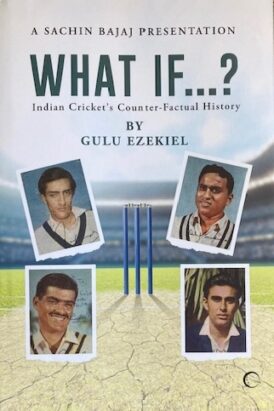What If …?
Martin Chandler |Published: 2025
Pages: 212
Author: Ezekiel, Gulu
Publisher: Global Cricket School
Rating: 4 stars

I don’t usually struggle to work out how to begin a review, but Gulu Ezekiel certainly had me scratching my head with this one. Publishers, vendors and purchasers alike always want to pigeon hole their books, and it is slightly frustrating to not quite be able to do so with this one.
But at least I can say what it isn’t. First of all it isn’t a work of fiction, so despite the title Gulu hasn’t attempted to describe, for example, what would have happened if the England tour of India of 1939/40, for which a touring party had been selected, had not been cancelled. Similarly he hasn’t tried to describe a world in which Donald Bradman was born an Indian, or if Sachin Tendulkar was not.
What If…? Isn’t a history of Indian cricket either, although the book is essentially historical in nature. There is a nod to the current state of cricket in the closing chapter, but for anyone whose interest in Indian cricket covers only the last forty years and who does not want to extend their knowledge further back the book will be of little interest.
On the other hand for those who are keen to know more about how Indian cricket made its way towards the dominant position it holds in the world game today, or who already have an interest in the history of the game’s development in India this is most certainly a book they are going to enjoy reading.
So what has Gulu done? He has chosen a number of aspects of Indian cricket history, doubtless his personal favourites. He then goes on to explain them, set them in context and, hence the book’s title, highlighted the turning points ie the What If moments, and then left his reader to form their own vision of what might have been.
To give an example one of the chapters in the book concentrates on the life and times of ‘Tiger’ Pataudi. In that sense it is partly biographical, but is more a description of the way a career in cricket unfolded. Gulu asks questions such as what would have happened had Tiger not lost 95% of his sight in his right eye whilst still at University, and what might have been the outcome had he not been forced as a result of Nari Contractor’s sickening injury to take on the captaincy at 21 in just his fourth Test. Moving on from there what might the outcome have been had Tiger not, amidst the political chicanery of the time, lost the Indian captaincy to Ajit Wadekar for the 1970/71 tour of the Caribbean.
And there has been, as anyone with even a passing knowledge of Indian cricket history, been a great deal of controversy behind the scenes over selection and related issues and, in particular, the captaincy, and those give rise to a myriad of other What If scenarios.
In order to find his material Gulu has gone right back to the origins of Indian cricket and the Parsees, so dominant in early Indian cricket. I always knew that the Parsees were a small group, but didn’t realise just how small (around 50,000 today), so a wholly disproportionate number of Indian cricketers come from that community, and Gulu covers the stories of all of the early tours.
The tours are examined in turn and, unsurprisingly, the bulk of the What If moments take place off the field. The last of the early tours was the Indian visit to England in 1911, a failure on the field. After that Indian relations with the rest of the cricket world were put on hold until the visit of an MCC side in 1926/27. Test status soon followed and three Test series took place, all against England, away in 1932 and 1936 and at home in 1933/34.
Again there are many What If moments, all of them either directly or indirectly linked to the period’s ongoing struggle between the personal ambitions of the princely patrons of the Indian game and the objective desire to need to field the strongest possible side under the leadership of the man best equipped for the job.
After the war comes Tiger’s story and, finally, India’s rise to prominence as the 1970s approached. Tiger’s rise to the captaincy, his fall from it and subsequent restoration to it feature in a number of chapters in which the presence of West Indies loom large. India’s record run chase in Trinidad and the subsequent bloodbath in Jamaica in the 1975/76 series give rise to plenty of What Ifs.
This a collection of fine stories, deeply researched and strong in emphasis of the points that Gulu wants his reader to think about. Add to that a very pleasing production and an excellent set of well chosen and well reproduced images and you have a book of which both author and publisher can be proud. It is recommended reading.






Leave a comment